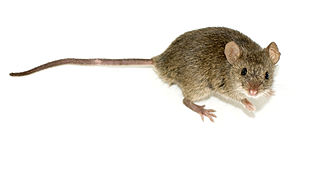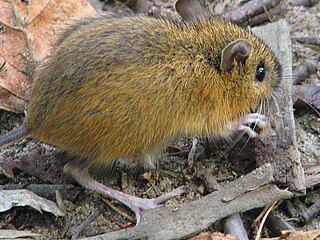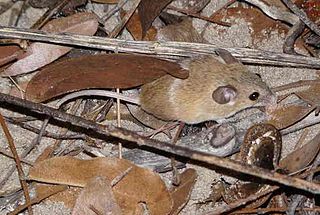
A mouse is a small rodent. Characteristically, mice are known to have a pointed snout, small rounded ears, a body-length scaly tail, and a high breeding rate. The best known mouse species is the common house mouse. Mice are also popular as pets. In some places, certain kinds of field mice are locally common. They are known to invade homes for food and shelter.

The house mouse is a small mammal of the order Rodentia, characteristically having a pointed snout, large rounded ears, and a long and almost hairless tail. It is one of the most abundant species of the genus Mus. Although a wild animal, the house mouse has benefited significantly from associating with human habitation to the point that truly wild populations are significantly less common than the semi-tame populations near human activity.

A fancy mouse is a domesticated form of the house mouse, one of many species of mice, usually kept as a type of pocket pet. Fancy mice have also been specially bred for exhibiting, with shows being held internationally. A pet mouse is inexpensive compared to larger pets, and even many other pet rodents, but mice are comparatively short-lived: typically only 2 to 3 years.

The term spiny mouse refers to any species of rodent within the genus Acomys. Similar in appearance to mice of the genus Mus, spiny mice are small mammals with bare tails which contain osteoderms, a rare feature in mammals. Their coats are endowed with unusually stiff guard hairs similar to the spines of a hedgehog; this trait is the source of the common name, spiny mouse.

The woodland jumping mouse is a species of jumping mouse found in North America. It can jump up to 3 m (9.8 ft) using its extremely strong feet and long tail.

The rosy-faced lovebird, also known as the rosy-collared or peach-faced lovebird, is a species of lovebird native to arid regions in southwestern Africa such as the Namib Desert. Loud and constant chirpers, these birds are very social animals and often congregate in small groups in the wild. They eat throughout the day and take frequent baths. Coloration can vary widely among populations. Plumage is identical in males and females. Lovebirds are renowned for their sleep position in which they sit side-by-side and turn their faces in towards each other. Also, females are well noted to tear raw materials into long strips, "twisty-tie" them onto their backs, and fly substantial distances back to make a nest. These birds are common in the pet industry.

The genus Mus or typical mice refers to a specific genus of muroid rodents, all typically called mice, though the term can be used for other rodents. They are the only members of the tribe Murini. However, the term mouse can also be applied to species outside of this genus.

The desert pygmy mouse is a species of rodent in the family Muridae. It is found in Angola, Botswana, Namibia, South Africa, Zambia, and Zimbabwe. Its natural habitats are dry savanna and subtropical or tropical high-altitude grassland.

The steppe mouse or mound-building mouse is a species of rodent in the family Muridae. It is found in grassland and other open areas in Austria, Bosnia and Herzegovina, Bulgaria, Croatia, Czech Republic, Hungary, North Macedonia, Romania, Serbia, Montenegro, Slovakia, Slovenia, and Ukraine.

The Algerian mouse, also known as the western Mediterranean mouse, is a wild species of mouse closely related to the house mouse, native to open habitats around the western Mediterranean.

The California deermouse or California mouse is a species of rodent in the subfamily Neotominae in the family Cricetidae. It is the only species in the Peromyscus californicus species group. It is found in northwestern Mexico and central to southern California. It is the largest Peromyscus species in the United States.
The country mouse also known as the pebble-mound mouse or eastern pebble mound mouse is a species of rodent in the family Muridae. It lives only in Australia, where it is considered rare. It was described by Thomas and Dollman in 1909.

The African pygmy squirrel is a species of rodent in the family Sciuridae. It is monotypic within the genus Myosciurus. It is found in tropical rainforests in Cameroon, the Republic of the Congo, Equatorial Guinea, and Gabon. It is not considered threatened, but likely declines locally due to habitat loss. Together with the least pygmy squirrel of Asia, the African pygmy squirrel is the world's smallest squirrel measuring about 12–14 cm (4.7–5.5 in) in total length and just 15–18 g (0.53–0.63 oz) in weight, which is less than a typical house mouse.

The western jumping mouse, is a species of rodent in the family Zapodidae. It is found in Canada and the United States.

Nannomys is a subgenus of the rodent genus Mus, the mice. They are known as the African pygmy mice. These species are native to sub-Saharan Africa, where they can be found in many types of habitat. There are 20 species.














